In botanical reference books, the May wild rose is often found under the names of wild rose cinnamon, rose May or cinnamon. This shrub begins flowering in May and has brownish cinnamon-colored shoots, hence the name. In the middle latitudes, the plant has become widespread, the beneficial properties of its fruits, as well as highly decorative qualities, are highly valued here.
Description of the wild rose in May, the period and duration of flowering
Rose cinnamon (cinnamon rosehip, or May) is a tall, profusely branching shrub.
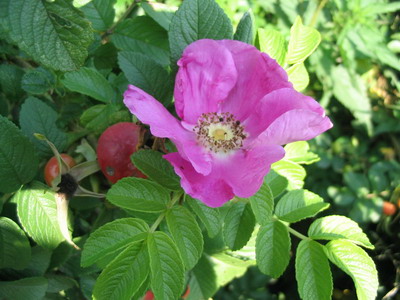
The habitat of the cinnamon rosehip is the entire European part of the continent. It grows in light forests, on the edges and clearings, meadows and thickets of mountain gorges, on rocky slopes.
Due to its description, the May wild rose is called cinnamon – it has red-brown shoots covered with numerous crooked thorns. The winter leafless cinnamon rosehip bush is a gift for florists , it is so organic in shape and unusual in color.
The description of the May wild rose is strikingly different from the wrinkled wild rose – it is impossible to confuse these plants.
Pay attention to the photo of a cinnamon rose – its leaves are complex, consist of 5-7 parts, oblong with a jagged edge, pubescent with bluish hairs:
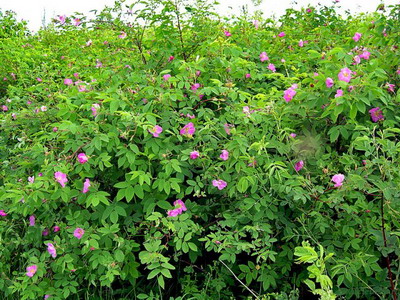
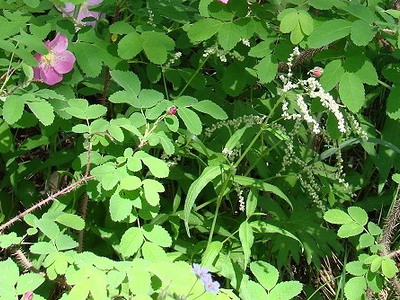
Garden forms, which this wild rose is also rich in, are represented by powerful shrubs up to 2 meters and higher with double flowers.
Cinnamon rosehip shoots have a three-year development cycle, and their total durability is 6 years. The progressive growth in height of each shoot lasts 1 year. In the next two years, it branches abundantly up to 2-3 orders, laying fruit buds, and blooms in the third year.
As you can see in the photo, the shoots of the May rose are formed in the lower part of the stem immediately after the death of the apical bud:
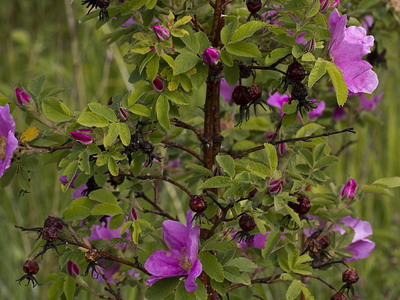

But the process of their appearance is much slower than that of wrinkled wild rose, which is reflected in flowering. It is not so plentiful and stretched.
The duration of flowering of the wild rose in May is from two to five days. Due to global warming, the flowering period of the wild rose in May is gradually shifting to earlier dates. On average, the plant blooms from May to July.
See what the cinnamon rosehip looks like in the photo below:
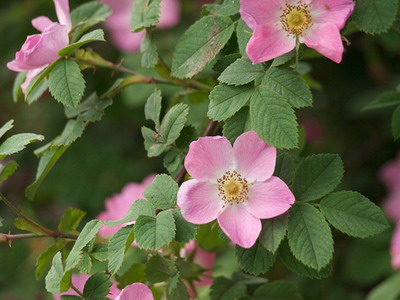

Rosa cinnamon (May) in culture and photos of shrubs
In cultivation, this type of wild rose is characterized by absolute frost resistance, enduring a drop in temperature to -42 °.
It is unpretentious in leaving, is content with rare waterings and poor soils. Does not tolerate flooding, damp warm air. The subtropical climate is not at all attractive for him.
Due to its high frost resistance, it is widely used in central Russia and northern latitudes as a rootstock for cultivated roses, although due to abundant branching and numerous shoots it cannot be called successful.
As a stock, two, and even three-year-old seedlings are used. Propagated by seeds, as well as root cuttings , offspring.
As you can see in the photo, seedlings of the May rosehip in the nursery are grown without picking, but with obligatory pruning “on the stump” in the second year of life:

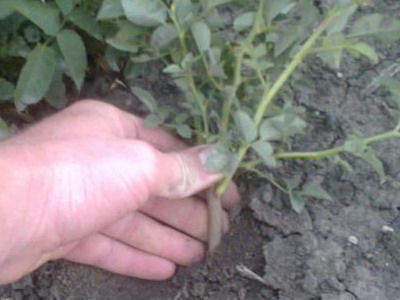
This is done to get strong shoots.
The easiest way to propagate is by root offspring. When planting, their above-ground part is shortened by half.
A productive way is root cuttings. Roots are harvested from autumn and stored in winter at + 2 … + 3 °. In the spring, they are cut into cuttings 5-10 cm in size and planted on ridges to a depth of 5-6 cm.
Medicinal properties of cinnamon (May) rose hips
Cinnamon rosehip is the richest of all other types of vitamins, being the main supplier of vitamin raw materials – the whole plant is healing, from roots to fruits and seeds:
- roots and bark are rich in tannins;
- in the leaves – carbohydrates, tannins and a whole set of vitamins (carotene, C, B, P, B1);
- in flowers – anthocyanins and flavonoids;
- fruits are fantastically rich in vitamins, especially C. Even in dry fruits it is 10% of the total volume, and in addition, a large amount of potassium, calcium, fatty acids, phosphorus and a complete set of trace elements, especially iron;
- fatty oil, vitamins, mainly E, and carotene were found in the seeds.
The medicinal properties of the May rosehip are used both in folk and traditional medicine in decoctions, infusions, ointments and as a component in various collections and preparations:
Roots in the form of a decoction are recommended for diabetes, hypertension, heart disease, as well as diarrhea, in the form of baths – for rheumatism and paralysis.
A decoction of the branches helps with acute pain from sciatica, rheumatism, stomach colic. A decoction of the leaves saves from nighttime urinary incontinence.
The flowers are infused and drunk as a tea, which soothes the nerves, relaxes them and cures inflammation. Lotions from the infusion also have a calming effect in case of skin diseases, abrasions, inflammations, burns. Internal inflammation miraculously heals a decoction of petals with honey. Even erysipelas lends itself to him.
But cinnamon rose hips are especially popular – from fresh, which are used for compotes, juices, jams, jams, liqueurs, etc., to dry ones, which are used as a healing agent, both in medicine and in everyday life.
May rose hips are an obligatory component in the preparations Karotomin, Holosas, as well as multivitamins under various names.
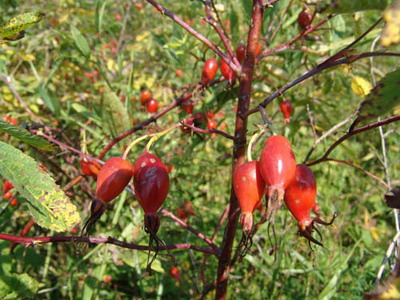
Vitaminized syrup – tasty and fragrant, curative for hypertensive patients. Rosehip oil in its properties is close to sea buckthorn, heals from trophic ulcers, stomach ulcers, gynecological diseases.
Boiled rose hips have their own specifics of action. They relieve colds, cystitis and other diseases of the urinary tract.
And the fatty seed oil is an excellent accomplice of enemas in the treatment of ulcerative colitis, and externally – for skin dermatitis, cracks, abrasions.
In addition to cinnamon, rose hips, Marre, Yundzilla have a high content of vitamins.
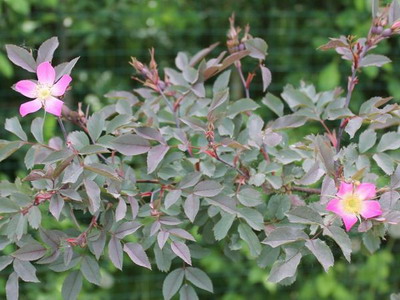

All these species are distinguished by long, straight-elongated sepals that remain until ripening, while other wild roses have no sepals or they are short and recurved, almost adjacent to the fruit.
Reproduction and care of the May rosehip
Rosehip planting material is easier to buy, but there is no guarantee that you will get good fruit. Rosehip itself can be propagated from a valuable mother bush by root shoots, layering, green cuttings. The most common method of propagation is by sowing seeds. Seeds have a very strong shell, which makes stratification difficult. Many are haunted by failures – the seeds have been sown, but there are no seedlings.
The best time to plant rose hips in the garden is in spring, before buds open. Can be planted in autumn.

Before planting, the roots and shoots of seedlings are shortened. In a permanent place they are planted 4-6 cm deeper. Shoots are pruned, leaving 2-3 highly developed buds.
It is necessary to plant several plants with the same flowering period in close proximity to obtain a stable high yield of fruits, because the wild rose needs cross-pollination.
Rosehip begins fruiting at 4-5 years. Further care for the ground part of the shrub consists in the annual removal of part of the fruit-bearing branches, which leads to rejuvenation of the plants and good yields for 20-25 years.
Agricultural practices associated with rosehip care: watering, fertilizing, weeding, loosening, protection from pests and diseases are the same as for all horticultural crops.








